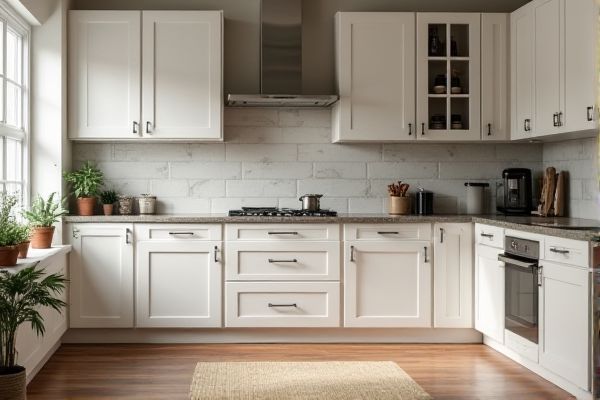
Shaker cabinets feature a simple, recessed panel design offering a timeless, versatile look, while slab cabinets showcase a flat, smooth surface for a modern, minimalist style. Discover which cabinet style best suits Your kitchen renovation needs by exploring the detailed comparisons ahead.
Table of Comparison
| Feature | Shaker Cabinets | Slab Cabinets |
|---|---|---|
| Design Style | Classic, Minimalist with a recessed panel | Modern, Sleek, Flat-front |
| Material | Wood or wood veneer | Wood, MDF, laminate, or metal |
| Visual Appeal | Warm, timeless, versatile | Clean, streamlined, contemporary |
| Customization | Easy to paint or stain | Available in various finishes and colors |
| Maintenance | Simple cleaning; grooves may accumulate dirt | Easy to wipe clean due to flat surface |
| Cost | Moderate to high | Generally affordable, varies by material |
| Best For | Traditional, farmhouse, transitional kitchens | Contemporary, modern, minimalist kitchens |
Shaker vs Slab Cabinets: Overview
Shaker cabinets feature a simple, recessed panel design with clean lines and minimal ornamentation, emphasizing craftsmanship and timeless appeal. Slab cabinets, also known as flat-panel cabinets, have a smooth, flat surface without any framing or detailing, offering a sleek and modern look. Both styles are popular in kitchen design, with Shaker cabinets suited for traditional and transitional spaces, while slab cabinets complement contemporary and minimalist aesthetics.
Design Differences: Shaker and Slab Styles
Shaker cabinets feature a distinctive recessed panel door with clean, simple lines and minimal ornamentation, emphasizing craftsmanship and traditional style. Slab cabinets, on the other hand, have flat, smooth fronts without any framing or panels, offering a sleek, modern, and minimalist appearance. The design differences between Shaker and slab cabinets influence the overall aesthetic, with Shaker fitting well in transitional and classic kitchens, while slab cabinets suit contemporary and industrial interiors.
Material Choices for Shaker and Slab Cabinets
Shaker cabinets typically feature solid wood or plywood with a veneer finish, providing durability and a classic, textured appearance ideal for traditional or transitional kitchens. Slab cabinets, often constructed from medium-density fiberboard (MDF) or plywood with laminate or painted finishes, emphasize a smooth, flat surface that suits modern or minimalist designs. Choosing between these materials affects cabinet resilience, maintenance, and overall style, with wood offering warmth and MDF providing cost-effective versatility.
Cost Comparison: Shaker vs Slab Cabinets
Shaker cabinets typically cost more than slab cabinets due to their detailed frame construction and added labor for assembling the recessed panel design. Slab cabinets are more budget-friendly, featuring a flat, smooth door surface that requires less material and labor to manufacture. Homeowners often choose slab cabinets for cost efficiency while selecting Shaker cabinets when prioritizing style and durability despite the higher price.
Durability and Maintenance Differences
Shaker cabinets feature a solid wood frame construction with recessed panel doors, providing strong durability and resistance to warping or cracking over time. Slab cabinets have flat, smooth doors often made from plywood or MDF with laminate or painted finishes, offering easier maintenance due to fewer grooves and crevices where dirt can accumulate. While Shaker cabinets may require occasional refinishing to maintain their wood quality, slab cabinets typically demand less upkeep and are more resistant to moisture and scratches.
Aesthetic Appeal: Which Fits Your Kitchen?
Shaker cabinets feature a timeless, minimalist design with clean lines and recessed panels, offering a versatile aesthetic that suits both traditional and modern kitchens. Slab cabinets present a sleek, flat-front style ideal for contemporary or minimalist spaces seeking a streamlined look. Choosing between Shaker and slab cabinets depends on your kitchen's overall style, with Shaker enhancing warmth and character while slab emphasizes simplicity and modernity.
Installation Considerations for Each Style
Shaker cabinets typically feature a simple, framed construction that allows for easier installation using standard cabinet mounting techniques, making them suitable for DIY projects or straightforward professional installation. In contrast, slab cabinets have a flat, frameless design that requires precise measurements and alignment for seamless integration, often demanding more careful handling during installation to avoid gaps or misalignment. Both styles benefit from proper cabinet anchors and level adjustments, but slab cabinets may require additional hardware for secure mounting due to their minimalistic design.
Customization Options: Shaker vs Slab
Shaker cabinets offer extensive customization options, including various frame styles, door panel designs, and finishes that can be tailored to match traditional or modern aesthetics. Slab cabinets feature a smooth, flat surface that emphasizes minimalism, with customization mainly limited to color, material, and hardware choices. Homeowners seeking personalized detailing often prefer Shaker cabinets, while those favoring streamlined, contemporary looks typically choose slab cabinetry.
Popular Use Cases and Kitchen Trends
Shaker cabinets are favored in modern farmhouse and transitional kitchens for their clean, timeless design that complements minimalist and rustic styles. Slab cabinets, with their smooth, flat surfaces, are popular in contemporary and modern kitchen trends emphasizing sleek, seamless aesthetics and handle-free designs. Both styles are widely used in open-concept kitchens where functionality and visual simplicity enhance the overall space.
Pros and Cons: Shaker vs Slab Cabinets
Shaker cabinets offer timeless appeal with a simple, recessed panel design that suits both traditional and modern kitchens, providing durability and ease of cleaning, though they may show wear over time due to their detailed edges. Slab cabinets feature a sleek, flat surface ideal for contemporary styles, offering easy maintenance and a minimalist look but can appear too plain or cold in warmer kitchen designs. Choosing between Shaker and slab cabinets depends on balancing aesthetic preferences with practical needs such as maintenance, durability, and overall kitchen style.
 homyna.com
homyna.com